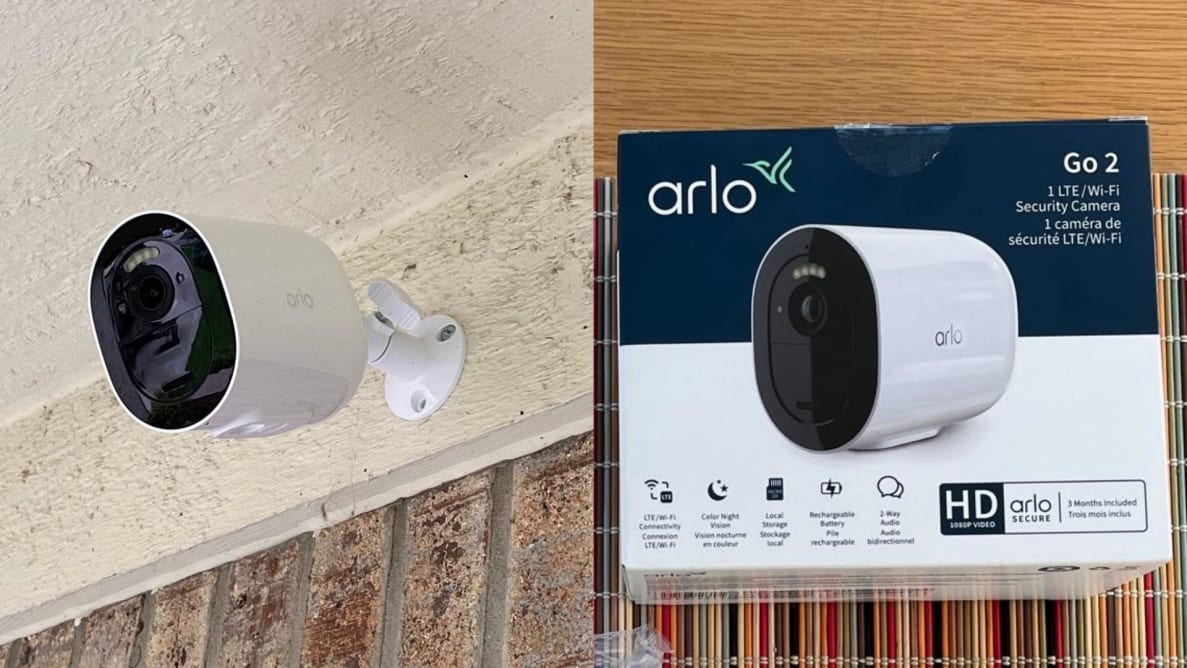Pros
-
Wire-free
-
Clear video
-
Works with Alexa and Google Assistant
Cons
-
Difficult setup
-
Paid subscription required
The Go 2 itself is at the high end of the price spectrum for outdoor security cameras, and on top of this there’s the cost of a data plan and, optionally, Arlo’s cloud-storage service. Even if money is no object, you may find the camera less than ideal. Plus, there’s a learning curve here, in part due to an aggressively unintuitive app.
About the Arlo Go 2
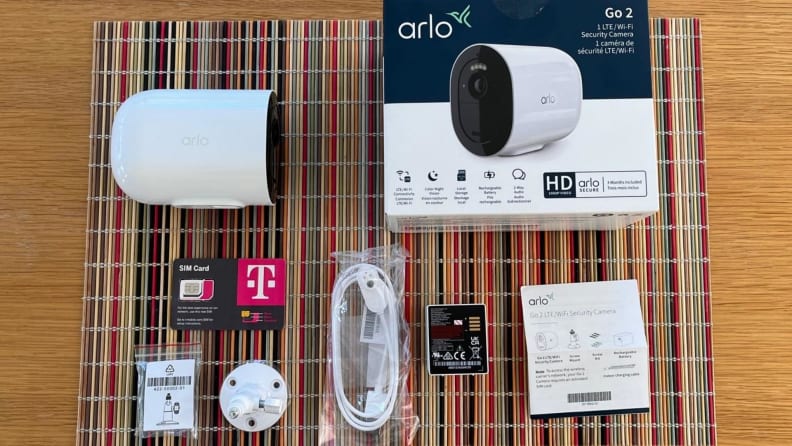
Everything included in the package.
These are the camera’s key specs:
- Colors: White
- Connectivity: 4G LTE, 802.11 b/g/n @2.4GHz
- Power source: Rechargeable battery
- Resolution: 1080p (1920 x 1080 pixels)
- Field of view: 130 degrees horizontal
- Audio: Two-way talk
- Smart assistant support: Alexa, Google Assistant
- Weather resistance: IP65
- Warranty: 1 year
The Arlo Go 2 is a large, fairly heavy camera. That’s due mostly to the 13,000-mAh battery, which Arlo says is good for up to eight months when connected to Wi-Fi and four months on full-time LTE.
The actual camera module lives inside a glossy white housing, which must be removed to access things like the microSD slot for video storage, the SIM card slot and the battery. There’s a screw-mount hole at the rear and a magnetic charging port on the bottom. The entire assembly is IP65-rated for weather resistance, meaning it’s fully protected against dust and should hold up against rain and snow.
What we like
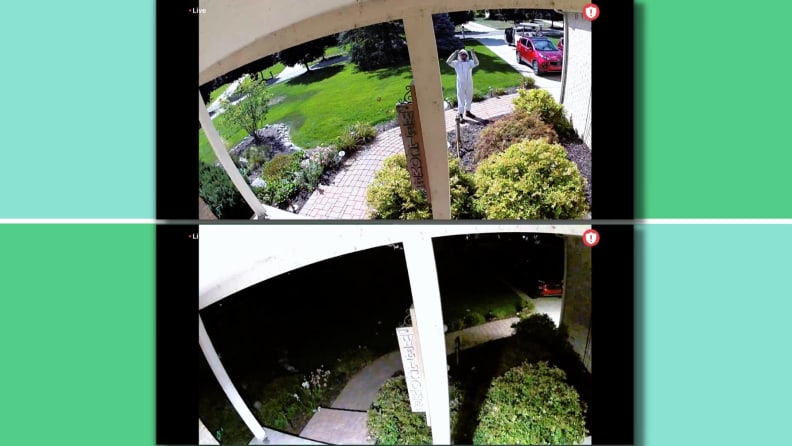
The live feed and camera quality are of good quality.
It’s a completely wire-free solution
The Go 2 is a wire-free security tool, able to run on battery power and connect to either a Wi-Fi network or one of three cellular carriers: T-Mobile, US Cellular, or Verizon. You’ll need to bring your own SIM card and data plan from whatever carrier you choose; Arlo provides quick links to all three from its product ordering page.
Because the battery is removable, you can keep a charged spare on hand, swapping it in as needed. That would be an ideal option if this is a remote camera you attend to only on rare occasion (like at a second home or rental property), and it gives the Go 2 a leg up over cameras with fixed, built-in batteries. Even better, there’s an optional solar panel ($60) that would obviate the need for ever dealing with the battery again. However, I wasn’t provided one of these for testing.
It’s great at capturing video and connecting to your smart home
Arlo’s been in the security-camera business for a long while, and it shows: The Go 2 is an extremely capable camera, producing crisp 1080p video during daylight hours and clear nighttime footage as well—in color, courtesy of onboard LEDs. Its 130-degree field of view results in an image that’s only slightly curved.
In my tests, the camera was fairly quick at establishing a connection over Wi-Fi; I could usually access the live feed within 3-4 seconds. Over LTE, connection varied quite a bit depending on where I was (at home, connected to my own Wi-Fi network, or out and about), but that’s to be expected.
Although you might be “too late” to catch what’s happening in real time, the camera does well at capturing video for later review.
If you have an Amazon or Google smart display, you can link the Go 2 and use voice commands to activate a live feed. The camera supports IFTTT integration as well, but there’s bad news for the Apple crowd: It doesn’t work with HomeKit, surprising given that Arlo’s Pro 4 Spotlight Camera does.
What we don’t like
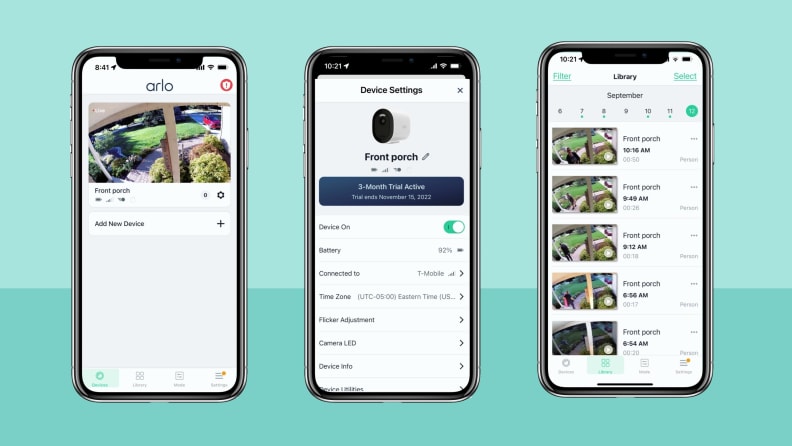
A not-so user-friendly app that doesn't seem to work half the time.
It’s a pain to set up
This is not a novice-friendly camera, at least with regard to installation. Arlo provides only a tiny printed instruction guide, one that doesn’t even mention charging the battery, let alone actually mounting the camera. Thankfully, there’s an online guide that’s much more detailed.
That first task requires removing the camera’s plastic housing, inserting the battery, then popping the housing back on. In my tests this last step took a considerable amount of force, to the point where I thought I must be doing something wrong.
Next, you connect a proprietary USB cable to the underside. Arlo doesn’t supply an AC adapter for it, so you’ll need to provide your own powered USB port. That’s not a big deal, but this is: Every time you need to recharge the camera, you have to unscrew it from the mount so you can bring it inside.
This means when you put it back later, you’ll almost certainly have to reposition it again. A magnetic mount would make this considerably easier. Alternately, consider the aforementioned solar panel (which I wasn’t able to test) to eliminate the need for manual recharging.
Speaking of positioning, Arlo’s ball-joint mount just isn’t good. It feels too small and insubstantial for such a heavy camera, and I had a difficult time achieving the angle I wanted. Plus, it’s a permanent mount, one that needs screws (and possibly anchors, depending on the surface) to stay put. For a camera with “Go” in its name, the Go 2 is anything but portable.
An Arlo Secure subscription is all but mandatory
Although the Arlo Go 2 has a microSD slot for local video storage, the camera’s best features require an Arlo Secure subscription. That will run you $3 per month for just the one camera, or $10 for two or more.
With that Basic plan you get not only remotely accessible cloud storage, but also 30 days’ worth of video history, an animated preview of your videos and much smarter motion detection: The app will differentiate between animals, packages, people and vehicles.
Arlo Secure also adds activity zones, priority support and smoke and CO2 detection, though obviously this last is intended for indoor cameras. For $15 per month, you can upgrade to Secure Plus, which adds 24/7 emergency response to the mix: One tap in the app lets you request fire, police or medical assistance to the camera’s location.
These services are competitively priced; other cameras have similar subscription fees. But Arlo generously provides three full months to test-drive the service free of charge, instead of the usual two weeks or 30 days.
The app’s motion-sensitivity settings are a nightmare
Outdoor cameras need to be smart about detecting motion, otherwise they’ll interrupt you too often or fail to capture important activities. Out of the box, the Go 2 fell into the former category: After setup, it sent non-stop motion alerts with just the slightest movement (like wind blowing a few leaves).
Indeed, when I stepped in front of the camera, the app alerted me every couple seconds; each new detection resulted in a new alert, which got old quickly.
No problem, I thought, I’ll just dial down the sensitivity. But after poring through the app, I couldn’t find the right setting. Eventually I had to turn to Arlo’s online knowledge base, which revealed a lengthy two-step process. First, you test motion sensitivity by venturing into the Device Utilities menu. This affords access to a slider you can move to adjust camera sensitivity, but it doesn’t actually save the setting.
For that, you have to exit the settings menu and dive deep into the Mode section of the app, where there’s a motion-detection “rule” with another slider that will save your preferred sensitivity setting.
This is some of the most unintuitive app design I’ve encountered. Even after learning all this, I’m confused about certain aspects of the Go 2’s operation. I suspect novice users will have a very difficult time getting the camera’s various settings adjusted properly.
Privacy
Arlo promises strict privacy when it comes to your videos (all of which are encrypted): The company doesn’t monetize personal data and won’t share videos or account information with law enforcement without your approval (or a legal warrant).
If you end your cloud subscription, any videos stored there get deleted permanently. And your account can be secured with two-factor authentication if you wish.
Should you buy the Arlo Go 2?
Maybe, if you need a battery-powered, LTE-connected camera and can deal with setup hassles
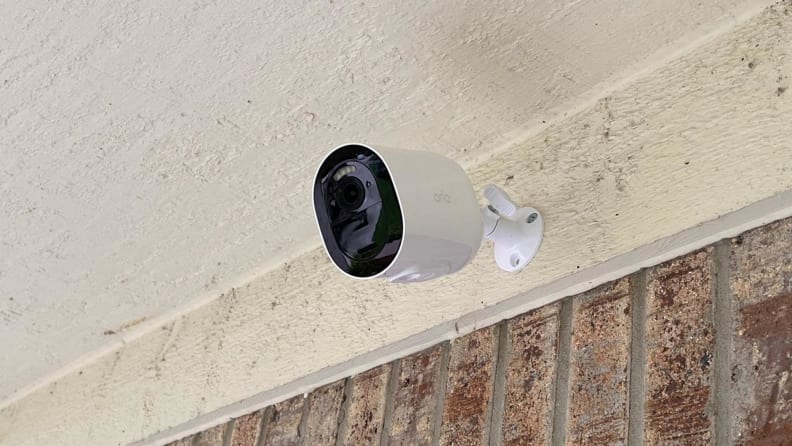
You're gonna have a hard time setting this one up.
In some respects the Arlo Go 2 looks better on paper than it does in real life. LTE connectivity solves the problem of weak or unavailable Wi-Fi, and a removable, rechargeable battery eliminates the need to run a power cord to an inconvenient location. Add an inexpensive solar panel to the mix and you never have to worry about power, period.
Unfortunately, the camera is expensive, heavy, hard to mount and not really designed for portability. The aforementioned solar option is all but essential to avoid the hassles of unmounting the camera or even just swapping in a fresh battery.
Those aren’t dealbreakers, however, and the Go 2 captures crisp, well-balanced video both day and night. It’s very good at detecting motion, though it can be overly aggressive about it, and just finding the proper settings to adjust in Arlo’s app is an exercise in frustration.
Meet the tester

Rick Broida
Contributor
Rick Broida has been writing about consumer technology since the days of the Commodore Amiga, meaning he’s not only incredibly old, but also the undisputed champion of Defender of the Crown.
Checking our work.
Our team is here to help you buy the best stuff and love what you own. Our writers, editors, and experts obsess over the products we cover to make sure you're confident and satisfied. Have a different opinion about something we recommend? Email us and we'll compare notes.
Shoot us an email